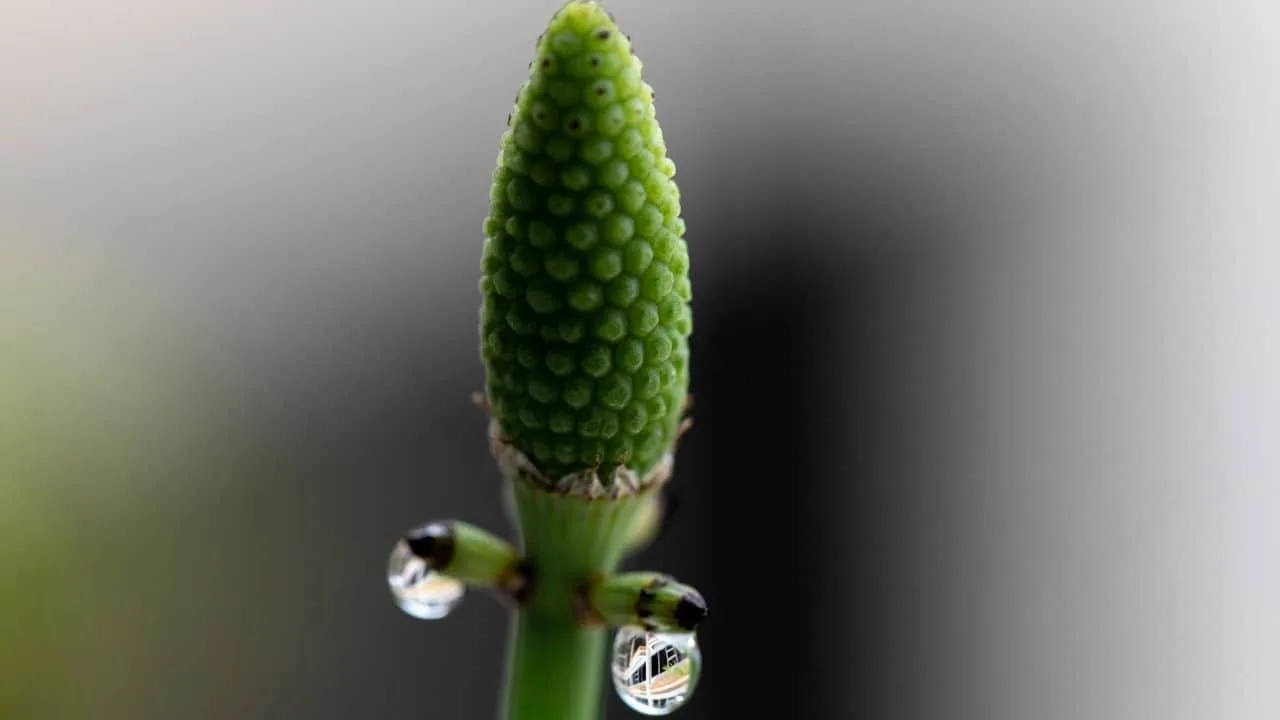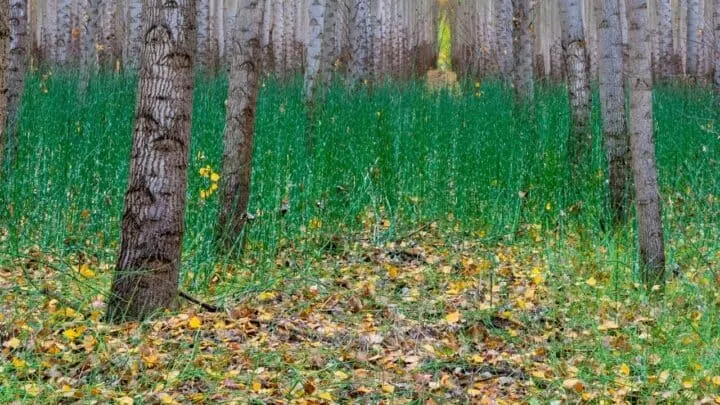Snake grass (known scientifically as Equisetum Hyemale and colloquially as rough horsetail) is a tough, hardy grass that is super resilient.
It can grow up to five feet tall. Its vertical stems don’t have leaves or flowers.
Snake grass is happy in many different soil types and spreads so easily, it is considered an invasive species in many locales (see below).
Apart from knowing how to plant it, it is equally important to know how to manage it so that you don’t lose control of it.
Table of Contents
How to Grow Snake Grass
First, take a freshly cut snake grass stem and place it in a bowl filled with water. When it has sprouted filigrees of new roots, move it into a pot filled with soil. When the plant has grown larger, you can plant it in water or in soil. Watch over the plant in the first few weeks to see if it needs watering if it’s planted in soil.
How to Plant Snake Grass
Planting Snake Grass in Soil

Growing Snake Grass in Soil
Rhizome means “mass of roots”. The rhizome in snake grass is a spherical, ball-like structure.
Begin by digging a large enough hole to accommodate the rhizome ball, the base of all snake grass.
This ball is what enables snake grass to take root in the ground and spread widely.
Snake grass propagates easily by nature, so you don’t have to be particular about where it is planted. It’ll grow as long as there’s some sun.
To stop it from getting out of control, you might consider building a retaining wall.

Retaining Wall for Snake Grass
Now that you’ve dug a suitable hole for your plant, place the plant in the hole until the rhizome ball gently touches the bottom of the hole.
Put dirt around the plant and pack it firmly so that it completely covers the rhizome. Fill the hole with dirt only until it’s level with the surrounding ground.
Where to plant Snake Grass
Snake grass is quite resilient and can survive in many different environments. It needs plenty of sunlight, but snake grass can thrive when placed in partial shade.
Be sure to select an area that’s mildly moist.
Snake grass’s roots tend to grow in a ball-like shape as they grow. Ensure you choose a container that can handle this.
Planting Snake Grass in a Container
When planting snake grass in a container make certain that the chosen container can drain just fine.
Snake grass is such an aggressive spreader that you’ll have to cover the container’s drainage holes to prevent the plant’s roots from escaping and spreading to other parts of your garden.
Tip: To protect drainage holes, place fine mesh all around the soil in the container.
Snake grass is supposed to be controlled and not spread too quickly if planted in a container.
On the other hand, you should plant your snake grass directly in the soil if you want it to spread.
Be warned that snake grass is likely to spread far faster and further than you would think.
This can be done with any general-purpose potting soil. Snake grass does not require any special nutrients.
You should add soil until the soil covers the plant’s roots. Provide an allowance of a few inches between the soil’s top and the container’s edge.
The hole should be approximately 2-3 inches broader and an inch shallower than the container. (In metric measurements, that’s 5-7.5cm broader and 2.5cm shallower.)
Check that the container sticks out about an inch (2.5cm) from the hole. You can push down on and twist the container to make it dig down a little deeper.
Fill in the holes around the container with freshly dug soil. Pack the soil tightly around your container.
To help the soil settle, water it.
In case you’re wondering: the idea behind partially submerging your snake grass in a pot in the ground is to stop it from spreading. I can’t stress too much how aggressively snake grass grows.
You’ve really got to be careful with it to let it overtake your garden.
Planting Snake Grass in Water

Planting Snake Grass in Water
When planting in water, ensure that the snake grass will be submerged no deeper than 4 inches (about 10 cm).
Note that you don’t put the rhizome into a hole when you’re planting snake grass in water, so how does the plant stay in one place? The answer is you tie the plant to a stake.
This prevents the plant from floating away.
When tying your snake grass to the holding stake, all you need to do is ensure that its rhizome is in contact with soil.
When planting in water, you can give the grass further stability by placing bits of gravel around its stem – but don’t overdo it!
You must not end up crushing the stem of the poor plant, or you’ll accidentally kill it.
Ensure that the snake grass will be submerged no deeper than 4 inches.
On top of the soil receiving the snake grass, place a layer of gravel about 1 inch (which is about 2.5 cm) high. The idea here is to protect the soil from either getting flooded or getting washed away.
Frequently Asked Questions about How to Grow Snake Grass
I’ve heard that snake grass is simple to grow. Is that true?
Snake grass does not require any special care other than choosing the right place for its growth. They grow well in sunlight or shade and seldom need watering. This plant easily spreads, and so needs regular thinning or dividing.
How do you trim snake grass, and will it grow from the trimmings?
Trim any spreading rhizomes, which look like tiny vines, and any fruiting stems. Divide the root ball to thin out snake grass. Yes, trimmings will grow new snake grass if given a chance. Therefore, it is best to dispose of the trimmings in the trash and not to compost them.
Afterword: How to Grow Snake Grass
Snake grass may be illegal in certain areas, like South Africa, where it is considered an invasive species. Always confirm the legality of planting snake grass with the local authorities before you go ahead and plant it.
As mentioned above, snake grass is resilient. It doesn’t require frequent watering except in exceptionally dry environments when you might have to water it regularly.

Daniel has been a plant enthusiast for over 20 years. He owns hundreds of houseplants and prepares for the chili growing seasons yearly with great anticipation. His favorite plants are plant species in the Araceae family, such as Monstera, Philodendron, and Anthurium. He also loves gardening and is growing hot peppers, tomatoes, and many more vegetables.


